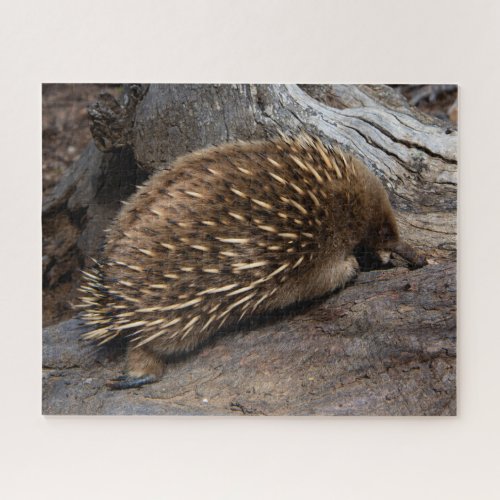Furry Spiky Echidna Animal Wildlife, 520 pieces Jigsaw Puzzle



Australia is known for it's amazing and exceptional wildlife. A perfect example of a unique animal is the Echidna. This cool jigsaw puzzle features a close up image of an Echidna that I spotted on one of my hikes in the Tasmanian wilderness. Can you piece it together? Be careful of the spikes! A great indoor activity. A challenge for yourself, or great for some quality time with family, friends or the kids. Make those rainy days go by quick and have lots of fun! And why not give one as a gift as well? Echidnas, sometimes known as spiny anteaters, belong to the family Tachyglossidae in the monotreme order of egg-laying mammals. The four extant species of Echidnas and the platypus are the only living mammals that lay eggs and the only surviving members of the order Monotremata. The diet of some species consists of ants and termites, but they are not closely related to the true anteaters of the Americas, which are xenarthrans, along with sloths and armadillos. Echidnas live in Australia and New Guinea. Echidnas evolved between 20 and 50 million years ago, descending from a platypus-like monotreme. This ancestor was aquatic, but echidnas adapted to life on land. Echidnas are medium-sized, solitary mammals covered with coarse hair and spines. Superficially, they resemble the anteaters of South America and other spiny mammals such as hedgehogs and porcupines. They are usually black or brown in colour. There have been several reports of albino echidnas, their eyes pink and their spines white. They have elongated and slender snouts that function as both mouth and nose. Like the platypus, they are equipped with electrosensors, but while the platypus has 40,000 electroreceptors on its bill, the long-beaked echidna has only 2,000 electroreceptors, and the short-beaked echidna, which lives in a drier environment, has no more than 400 located at the tip of its snout. They have very short, strong limbs with large claws, and are powerful diggers. Their claws on their hind limbs are elongated and curved backwards to help aid in digging. Echidnas have tiny mouths and toothless jaws. The echidna feeds by tearing open soft logs, anthills and the like, and using its long, sticky tongue, which protrudes from its snout, to collect prey. The ears are slits on the sides of their heads that are usually unseen, as they are blanketed by their spines. The external ear is created by a large cartilaginous funnel, deep in the muscle. At 33 °C, the echidna also possess the second lowest active body temperature of all mammals, behind the platypus.


